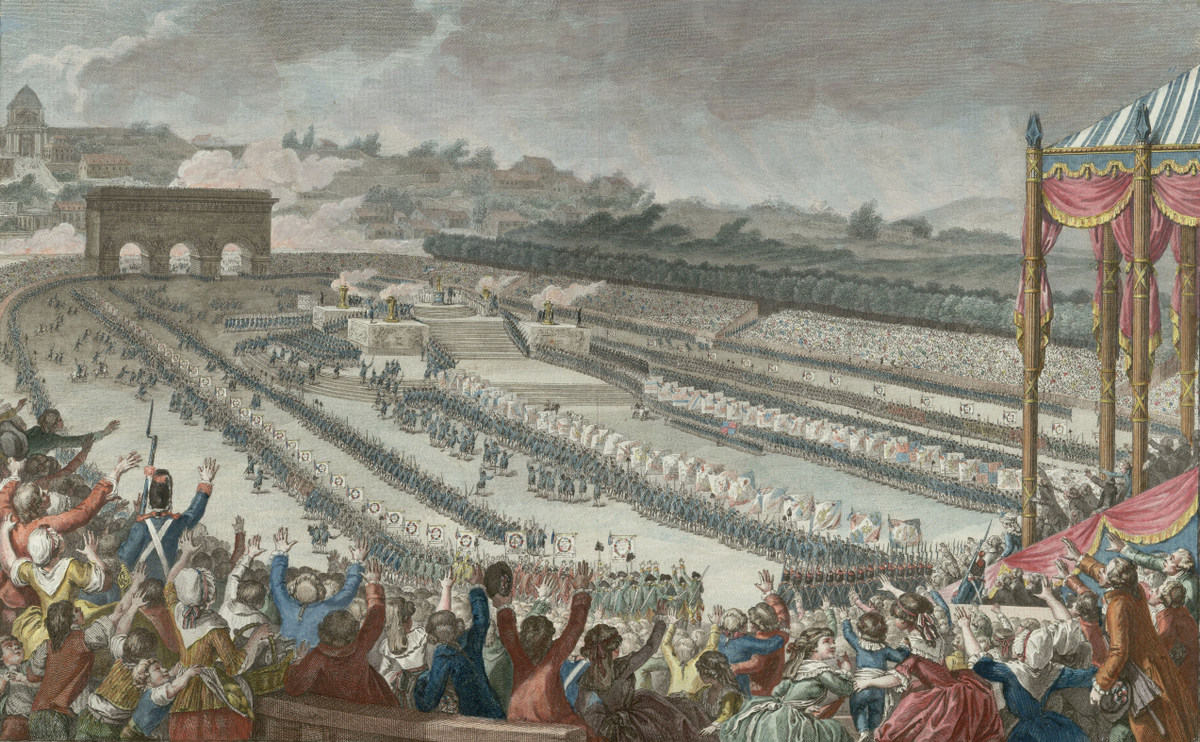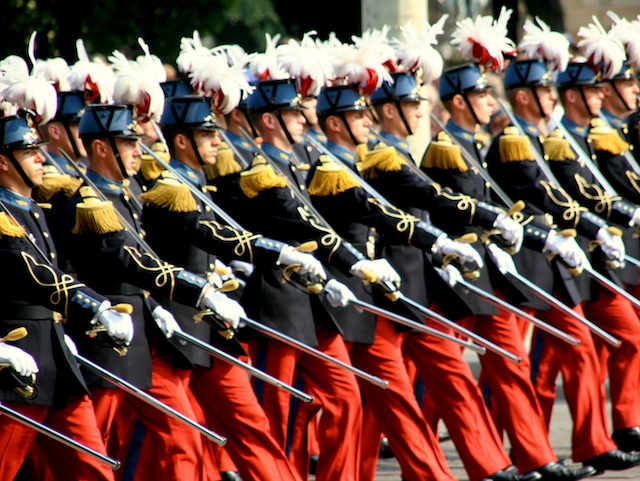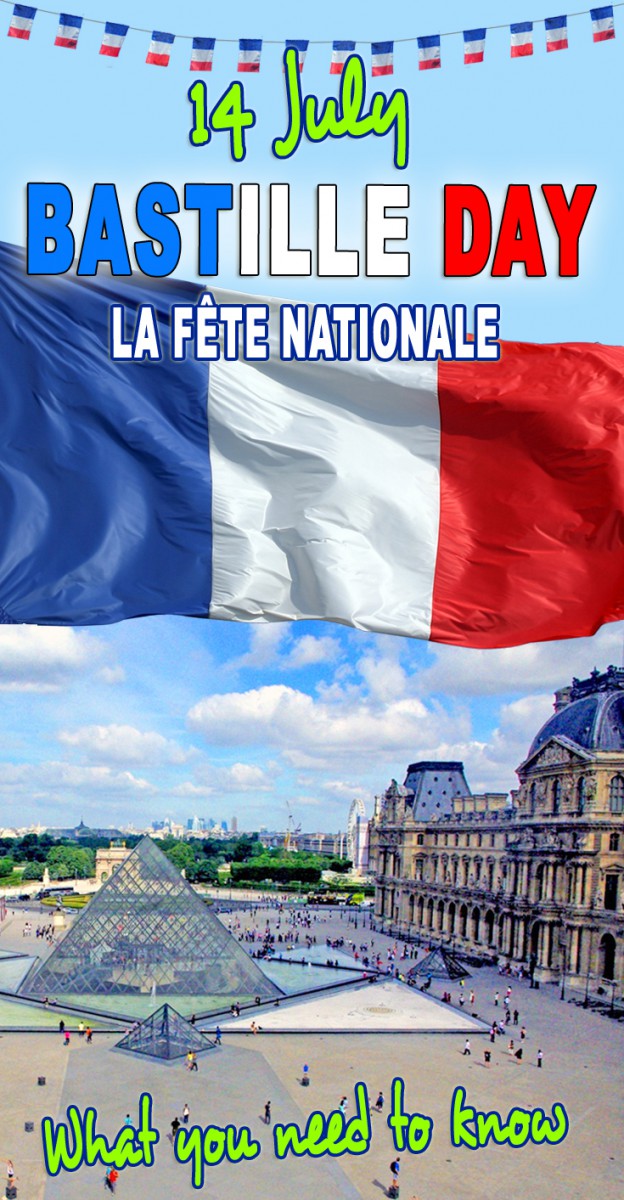What makes Bastille Day so unique to the French? Mainly because this is the French national holiday! The celebration takes place on the 14th of July each year. The French call it “Fête Nationale” and more commonly “le quatorze juillet”.
🎦 Watch our short video on the origins and traditions of Bastille Day:
The Storming of the Bastille
Bastille Day commemorates the 1790 “Fête de la Fédération”. This celebration occurred on the first anniversary of dismantling the Bastille fortress on 14 July 1789. The Storming of the Bastille was an essential symbol of a new era in the country. It preceded the First Republic.
The Storming of the Bastille happened on the morning of the 14th of July 1789 by a revolutionary mob from the Faubourg Saint-Antoine. In fact, attacking the Bastille represented a symbolic act against royal authority in central Paris. By late afternoon, its seven prisoners were freed. This first act of the French Revolution quickly became a significant date in French history.

The fortified prison was dismantled between July 14, 1789, and July 14, 1790. Did you know its stones were partly used to build the Pont de la Concorde? Eighty-three stones were carved into miniature Bastille replicas before being sent to the provinces. The fortress was situated in the present-day Place de la Bastille site.
Learn more about the remains of the Bastille fortress in Paris and France!
La Fête de la Fédération

In fact, Bastille Day or ‘la Fête Nationale’ does not directly commemorate the storming of the Bastille. It was about the ‘Fête de la Fédération’ on the Champ de Mars on July 14, 1790. On that day, thousands of Parisians gathered to celebrate the new French Nation’s unity and its people’s national reconciliation.
It was the National Assembly that organised a ‘general federation’ based on the suggestion of the Commune of Paris.
On that occasion, Jean Sylvain Bailly, mayor of Paris, declared:
“We suggest that this meeting (…) be sworn on the next 14 July, which we shall all see as the time of liberty: this day shall be spent swearing to uphold and defend it”.
Charon, President of the Commune of Paris, stated the famous motto:
“Frenchmen, we are free! Frenchmen, we are brothers!”
100,000 spectators on the Champ-de-Mars!
In 1790, the Champ-de-Mars was quite far outside the centre of Paris. It was a convenient gathering place, and a vast stadium was set up with the help of thousands of volunteers. They built earth steps for 100,000 spectators on each side of the field.
The recently-built Ecole Militaire (military school) was used to welcome members of the National Assembly. A vast tent to house the king’s step was right before it. A triumphal arch was built on the other side of the Champ-de-Mars (where the Eiffel Tower now stands). An altar for the celebration was set up at the centre of the Champ-de-Mars. It was called ‘Autel de la Patrie’ (the Nation’s Altar), a symbol of civility and the nation during the French Revolution.
A delegation from the United States, led by John Paul Jones, founder of the US Navy, was present at the Champ-de-Mars. It was the first time in history that the US flag was flown outside the United States.
Despite the intense rain, a large number of people gathered. Charles-Maurice de Talleyrand-Périgord, bishop of Autun (who did not hide his atheism!), and 300 priests celebrated the mass. King Louis XVI arrived from the castle of Saint-Cloud.

La Fayette’s oath to the nation
The Marquis de La Fayette, captain of the National Guard, came riding a white horse. Once on the altar, he was the first to take an oath in the name of the Federated National Guards:
“Nous jurons de rester à jamais fidèles à la nation, à la loi et au roi, de maintenir de tout notre pouvoir la Constitution décrétée par l’Assemblée nationale et acceptée par le roi et de protéger conformément aux lois la sûreté des personnes et des propriétés, la circulation des grains et des subsistances dans l’intérieur du royaume, la prescription des contributions publiques sous quelque forme qu’elle existe, et de demeurer unis à tous les Français par les liens indissolubles de la fraternité.”
We swear forever to be faithful to the Nation, to the Law and to the King, to uphold with all our might the Constitution as decided by the National Assembly and accepted by the King, and to protect according to the laws the safety of people and properties, transit of grains and food within the kingdom, the public contributions under whatever forms they might exist, and to stay united with all the French with the indestructible bonds of brotherhood.

The King’s oath
Following the statement of the President of the National Assembly, King Louis XVI took an oath of allegiance to the Constitution:
“Moi, roi des Français, je jure d’employer le pouvoir qui m’est délégué par la loi constitutionnelle de l’État, à maintenir la Constitution décrétée par l’Assemblée nationale et acceptée par moi et à faire exécuter les lois.”
I, King of the French, swear to use the power given to me by the constitutional law of the State to maintain the Constitution as decided by the National Assembly and accepted by myself and to enforce the laws.

Then the crowd cheered and sang ‘Te Deum’. The celebration continued in many parts of Paris with balls where people danced, sang and toasted.
It was only in 1880 that the 14th of July became the National Day of France at the suggestion of Benjamin Raspail.
👉 If you are interested in seeing what Bastille Day in France is really like, why not explore all that France has to offer with DFDS Seaways voucher codes? Travel affordably by ferry and experience the celebrations of Bastille Day authentically at a great price
The Bastille Day Military Parade
Among the festivities held on the morning of 14 July, the most significant event is the military parade. Dating back to 1880, it takes place on the Champs-Elysées in Paris.
Facts and Figures of the Military Parade
In 2023, the military parade involved:
- 6,500 participants, including 5,100 soldiers on foot
- 157 vehicles and machines
- 200 riders of the Republican Guard
- 86 dogs
- 62 motorbikes
- 66 aircrafts
- 28 helicopters
- 1,200 metres of the parade
- a length of 2 hours (review, parade, final)
The soldiers parade down the Champs-Elysées, from the Arc de Triomphe to the Place de la Concorde, in front of the President of the Republic, the French government, foreign Paris-based ambassadors and other officials.

For many, the French parade is by far the largest and oldest in the world. Undoubtedly, the setting of the Champs-Elysées contributes to its popularity as the avenue is large and long enough to host such an event.
A parade amid famous Parisian landmarks!
Many of Paris’ world-famous landmarks also add a magical touch to it:
- the Arc de Triomphe, with a very large French flag floating under its arch,
- the Place de la Concorde with the traditional Presidential platform set up for the occasion,
- the Grande Arche de la Défense … and
- the Eiffel Tower, which is never far away!

The course of the parade
The parade is opened by cadets from the most prestigious French military schools (Ecole Polytechnique, Saint-Cyr and Ecole Navale). The future officers are then successively followed by military infantry troops, including the French Foreign Legion troops and motorised and armoured troops.
The aerial parade is one of the most awaited moments that delight old and young alike. Hundreds of aircraft and helicopters participate, especially the “Patrouille de France”. An impressive flypast is a unique event in the sky of Paris, as flying over the city is forbidden for security matters.

Parallel to the foot parade, the ceremonial flight of aircraft performs along a straight line following the “Historical Axis” (La Défense, the Champs-Elysées and the Tuileries).

In 2019 the display included a man rocketing through the air on a flyboard device—an incredible invention of French former jet-skiing champion Franky Zapata.
Bastille Day guests of honour
Since Mitterrand’s presidential mandate, it has become a tradition to invite guest military troops from other allied nation-states of France. A few memorable years:
- 1999: Morocco
- 2002: the USA
- 2004: the UK (for the centenary of the Entente Cordiale)
- 2005: Brazil
- 2007: Germany. In 1994, Mitterrand’s invitation to German troops stirred up some memories as it was the first time German soldiers had paraded in France since World War 2! Another great occasion of reconciliation occurred in 2007 – President Sarkozy’s first parade – delegations from the 26 member-states of the European Union passed down the Champs-Elysées. Never before had such a gathering of European army delegations been organised, with the European flag flown and the European anthem played.
- 2015: Mexico. The military parade commemorated the 70th anniversary of the end of World War 2.
- 2016: ANZAC troops (Australia and New Zealand)
- 2017: the US
- 2018: Japan and Singapore
- 2019: the European Intervention Initiative, a joint military pact of 10 countries created the previous year (Belgium, Denmark, Estonia, Germany, Finland, France, the Netherlands, Portugal, Spain, and the UK)
- 2020: Cancelled
- 2021: Task Force Takuba, a group of special forces operating in Mali and the wider Sahel region, comprising soldiers from eight European countries (France, Belgium, Estonia, Italy, the Netherlands, Portugal, Sweden and the Czech Republic).
- 2022: the parade is opened by the countries of Europe’s Eastern Front, in the context of the war in Ukraine: Estonia, Latvia, Lithuania, Poland, the Czech Republic, Slovakia, Hungary, Romania and Bulgaria.
- 2023: India, with the theme “Nos forces morales” (Our morale forces). This year, France is celebrating the 25th anniversary of its partnership with India in the presence of Prime Minister Narendra Modi. 240 members of the Indian armed forces opened the foot parade, and three Indian Rafales flew past in the flypast.
The Paris parade is arguably one of France’s most popular events broadcast on French TV. It is an event during which the French National Anthem (La Marseillaise) is proudly sung.
The historic cancellation of the Bastille Day parade in 2020
In 2020, the French authorities cancelled the Bastille Day military parade on the Champs-Elysées over coronavirus.
Due to social distancing norms, the parade was replaced with a ceremony to pay tribute to health workers fighting the coronavirus pandemic.
The French president and officials attended a much smaller military ceremony at the Place de la Concorde, where the parade typically ends.
The event gathered 2,000 participants and 2,500 guests, with strict respect for social distancing rules.
However, the popular flypast occurred as usual and was dedicated to medical personnel and all others “mobilised against the virus”.
2024: The Bastille Day Parade to tie in with the Paris 2024 Olympic Games.
The traditional 14th of July military parade will not be held on the Champs-Élysées in 2024. Exceptionally, it will take place on the Avenue Foch between the Arc de Triomphe and Place Dauphine.
This route change is due to technical constraints. The Place de la Concorde will be occupied by the urban events of the 2024 Paris Olympic Games, which start on July 26th.
On this occasion, the Olympic torch will be part of the celebrations of the Fête Nationale and, more particularly, the military parade.
This is not the first time the 14th of July military parade has not been held on the Champs-Élysées. As the Ministry of the Armed Forces points out, “it wasn’t until 1980 that the ceremony was definitively fixed” on the famous avenue. Before that, it was held at the Longchamp racecourse (Bois de Boulogne). It was first held on the Champs-Elysées in 1919 to echo WWI.
After the Second World War and until 1980, the venue changed regularly. In the 1970s, it occurred in eastern Paris and twice between Bastille and République – sometimes in one direction, sometimes in the other. At the end of that decade, the celebrations occurred before the École Militaire. More recently, COVID-19 forced another significant change: as mentioned above, the parade was cancelled in 2020 and replaced by a simple ceremony at Place de la Concorde.
Meet the soldiers at the Invalides
After the parade, the army usually invites everyone to meet the soldiers and get close to the machines (helicopters, tanks, etc.) on the Esplanade des Invalides from 2 pm.
After the parade: c’est la fête !
Until 2009, the French President hosted a garden party at the Elysée Palace immediately after the Parade. In 2008, some 8,000 guests from all over the country were invited to join the party at the Presidential Palace.
The great classical music concert on the Champs de Mars
At 9 pm, a major classical music concert is held on the Champs de Mars. In 2023, the 11th edition of this concert will bring together the Orchestre National de France, the Chœur et la Maîtrise de Radio France and leading international soloists to offer the public a free concert on the theme of equality. The show ends with singing a vibrant and traditional Marseillaise, the French anthem. And just after comes the fantastic fireworks display.
Fireworks at the Eiffel Tower
In Paris, the most prominent fireworks display in France will be fired from the Eiffel Tower on Friday 14 July, from 11 pm onwards on the theme of “La Liberté”.
Each year, the fireworks display offers a breathtaking 30-minute visual and aural show. You’ll need to come a long way in advance to get a good view, but it’s an event you’ll want to see at least once in your life!
The 14th of July balls
The tradition of the 14 July ball dates back to at least 1880. It’s a much-loved event in France, with all the pomp and wild dancing to the accordion, orchestra or recorded music, even if it sometimes feels a little old-fashioned. The Balls dansants are a way of getting together, relaxing, forgetting everyday worries and having a party! For some, it’s a reminder of the good old days and the Belle France; for others, it’s a new experience.

The Paris Fire Brigade Balls
It’s a tradition followed by many Parisians. The Paris fire brigade balls (Bals des Pompiers) are a not-to-be-missed event on 14 July. The town halls of the Paris arrondissements and the fire stations offer parties, usually free of charge (or there is a small admission charge).

Celebrate Bastille Day across France!
But of course, Paris is not the only place to celebrate Bastille Day in France. From every city to every village, the “Fête Nationale” is the occasion for Bals Dansants (balls), firework shows, local parades, or large-scale picnics.

For more info about the origins of Bastille Day, check out:
- Discover the famous Place de la Bastille in Paris
- Tracing the Remains of La Bastille Fortress in Paris
- The National Symbols of the French Republic
- Why La Marseillaise is France’s National Anthem?
- All there is to know about the Tricolour, aka the French Flag
- Read more on Wikipedia
- the complete programme for Bastille Day in Paris
Pin it for later
Did you like what you read? If so, share this article on Facebook and Twitter, or pin it on Pinterest:









Very nice article! For more information and intriguing details about the French Revolution, the Bastille, and the Bastille key that Lafayette gave to Washington (a replica of which Mount Vernon recently gave to both Macron and Trump, check out the book “George Washington’s Liberty Key” and http://www.LibertyKey.US
I think you mean "hit hard" by covid, not "hardly hit", which means 'not hit very much'. (Isn't English wonderful?!)
Thank you, Tom, for your help; I really appreciate it! I have corrected the sentence, so it should make sense now 🙂